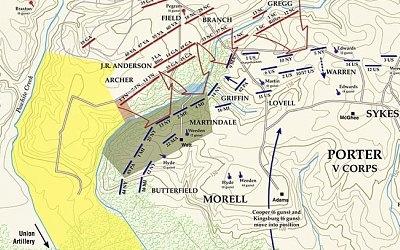Thanks to the Civil War Trust and the Commonwealth of Virginia, the Gaines' Mill unit of Richmond National Battlefield Park has grown from the 65 acres protected since the 1920s to 345 acres.
The new acreage protects the site of some of the bloodiest fighting of the Seven Days’ Battles. Gaines' Mill was Gen. Robert E. Lee’s first major victory as commander of the Army of Northern Virginia. The battle was also the first time that aerial intelligence balloons were used by both Union and Confederate forces.
The Civil War Sites Advisory Commission gave Gaines’ Mill a Priority I, Class A designation in 1993, marking it as one of 11 top candidates for preservation efforts in the nation. The Civil War Trust’s campaign to raise private funds to reach the $3.2 million goal included a $1,521,443.07 transportation enhancement matching grant awarded by Virginia Secretary of Transportation Sean T. Connaughton. That grant is among the largest ever allocated from that state program. Connaughton said a hallmark of the state’s dedication to battlefield preservation is Virginia’s “ongoing collaboration with the Civil War Trust, a partnership that is creating a legacy that will last for generations to come.”
The Trust says the entire 285-acre parcel lies within the authorized boundary of Richmond National Battlefield Park, so it intends that the land will be turned over to the National Park Service for long-term stewardship and interpretation. “This and other Trust-owned properties in the Richmond area will be transferred as part of a larger initiative announced by Secretary of the Interior Ken Salazar and NPS Director Jon Jarvis during an event at the Glendale Battlefield in February 2012,” says the organization.
“The inclusion of this truly historic land will be a tremendous boon to the Park,” said superintendent Dave Ruth. “It will open up new opportunities for us to tell the incredible stories of this region during the tumultuous days of the Civil War era. For the first time, visitors will be able to retrace the dramatic Confederate charge of June 27, 1862 — by many accounts, the Robert E. Lee’s largest assault of the war.”
Chris Peace, a long-time vocal advocate of battlefield preservation initiatives in the Old Dominion, was among the event’s distinguished guests. “Civil War battlefields like Gaines’ Mill are not only powerful reminders of our region’s rich past, but they are also dynamic engines that help drive Virginia’s future,” said Peace. “These incredible sites draw many thousands of tourists each year, injecting vigor into our economy and providing proven and measurable benefits to our communities.”
Virginia Director of Historic Resources Kathleen Kilpatrick elaborated further on the numerous benefits of battlefield preservation. “By working through public-private partnerships like the one we recognize today, we are able to make tremendous strides in setting aside some of our Commonwealth’s most historic sites. Once preserved, these hallowed grounds provide inspirational and enlightening outdoor classrooms for students of all ages and, in many cases, safeguard sensitive environmental resources as well.”
The Civil War Trust reports that the “scope of this preservation campaign, first announced in the waning days of 2011, dwarfs all earlier efforts at Gaines’ Mill. The bulk of previously protected land was purchased in the 1920s by a group of dedicated Richmond residents — including legendary historian and Richmond News Leader editor Douglas Southall Freeman. Calling themselves the Richmond Battlefield Park Corporation, the group purchased 60 acres south of Boatswain’s Creek that included a portion of the Union line. In 1932, the Corporation donated all of the land it had purchased at Gaines’ Mill and other nearby battlefields to the Commonwealth of Virginia, creating a state park; four years later, the land was transferred to the National Park Service as the foundation for Richmond National Battlefield Park.”
That was the extent of preservation until recent years when the focus shifted to the Confederate lines north of Boatswain’s Creek. The Richmond Battlefields Association saved 3 acres, then, in 2011, the Civil War Trust bought two more acres farther to the east. The new acreage starts at those parcels and wraps around the existing National Park Service Gaines’ Mill Battlefield.
The Civil War Trust is the country’s largest nonprofit battlefield preservation organization in the United States. “To date,” the Trust says, “it has preserved more than 34,000 acres of battlefield land in 20 states, including 17,190 in Virginia."




Comments
All for this preservation but it would appear that contrary to the verbage of the article, this new area doesn't actually cover ground where major fighting occurred. I would be interested in knowing what is the status of the acreage where the battle lines are drawn and whether there are efforts underway to acquire those.
FF, you can find additional background on the landscape in question, and the military movements that occurred there, at the Civil War Trust's website. They offer a lot of material on the historical value of the property.